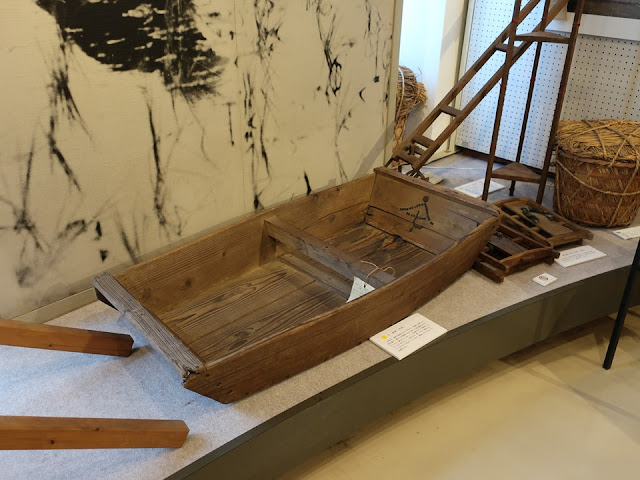Kamagaya city is east of Tokyo, and there were horse stock farms in
this region.
千葉県鎌ケ谷市は東京の東、内陸部にある。かつて、幕府直轄牧場があった。
Ancient times 古代
 |
| Entrance、エントランス |
It is a small but a good museum. The admission was free when I visited,
無料だったが、きっちりと展示されている。 |
Excavated things in Nakazawa village
中塚貝塚からの出土品
|
Horse stock farms 軍用馬の放牧場
 |
| The facility to catch horses、野馬捕り込めの施設 |
The shogunate placed farms in this area. In Koganemaki stock farms, there were 1,000 horses. The shogunate caught horses once a year, and they were sorted into two kinds. One was for military use, another one was for selling to people. Many people went to see the horse capturing event (Matsudo Museum, Ema board offered to Kouya-kannon temple).
下総小金中野牧跡(捕込)。年に一度の野馬狩りには、見物人がでる(松戸市立博物館、幸谷観音野馬捕りの献額)。幕府は、軍馬を養育のために房総に牧を設置した。小金牧では、最盛期には1,000頭もの野馬が放し飼いにされていた。捕込は、野馬を追い込み捕えて、軍馬として養成する馬と払い下げる馬とに選り分ける、3区画からなる施設だった。
Old documents 古文書
 |
Travel diary of a samurai who went to watch the American warships in
1853. ペリー来航時に現地調査で出張した武士の旅日記
|
 |
Text book in the Edo period “Teikin-ourai”
江戸時代の教科書、庭訓往来
|
Articles of everyday use 民具
The photo below is a tray with legs. We used them before tables became popular in the 19th century.
下の写真は膳。西洋の影響を受けて、ちゃぶ台が広まるまでは膳を使っていた。
Sake shops owned containers and
people borrowed them.
酒屋さんの所有物で、酒飲みはそれを借りて酒を買ったという。 |
| Boat for muddy rice fields、ぬかるむ田んぼで使う田舟 |
It was used not only for rice planting but also for harvesting.
Reference: Rice
Farming Process and Annual Events 稲作と年中行事 田植だけでなく、稲刈りの時も使うそうな。
 |
| Straw horse for the star festival “Tanabata”、七夕の馬 |
It is made on the 7th of August and is hung under the
eaves. People throw it on the roof next morning. Their ancestors get on it and
back to the house. The custom is a bit different from it in Joso (Toyota-jyo
(Joso City local exchange center) 常総市地域交流センター・豊田城).
月送りの8月7日に作り、昼ごろに軒先に吊り下げる。翌朝、屋根の上に投げあげる。先祖が帰ってくるときの馬になるという。子どもが遊んでいた豊田市と少し違う。 |
| Kamagaya museum 鎌ケ谷市郷土資料館 |
5 funs(楽fun)were
found. Visited in August, 2018
Next post (Museum in Chiba, neighboring city of Kamagaya):
Official website : https://www.city.kamagaya.chiba.jp/smph/sisetsu/kyoudo_2/kyoudo/index.html
(in Japanese), accessed in September, 2020Next post (Museum in Chiba, neighboring city of Kamagaya):






Comments
Post a Comment